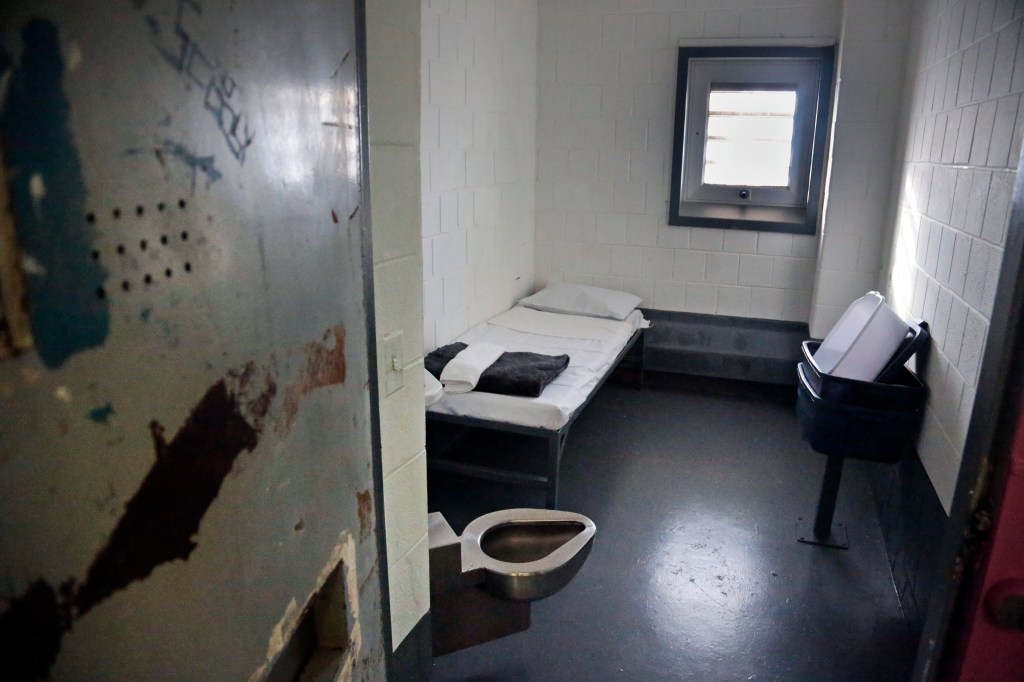New York City doesn’t have its very own Guantanamo Bay, but Rikers Island comes pretty damn close. Made up of ten different jails, the floating mass of a prison complex is where local criminals—mostly minorities—go to disappear into the purgatory of our criminal justice system. Stuck between the Bronx and Queens, Rikers has remained a symbol of American bureaucratic backwardness for decades to city and federal law enforcement agencies alike. One recent, glaring example is that of Kalief Browder, the now-19-year-old subject of a recent New Yorker profile who was lost in the place for three years without trial for a low-level “broken windows” infraction. In his case, the crime was the alleged theft of a backpack.
As of late, Rikers has made for even rougher headlines with its own version of a torture report: stories of “Fight Club”-esque violence instigated by guards that have led to an array of serious injuries and even deaths, including those of some mentally ill patients. But finally, somewhat like recent relocation efforts at Guantanamo, it seems as if the tide may be shifting towards some sort semblance of sanity off the shores of New York.
Videos by VICE
Almost immediately upon entering office last January, New York Mayor Bill de Blasio faced pressure from all sides to reform Rikers: After a damning investigation by the New York Times into 129 inmates seriously injured by guards, US Attorney Preet Bharara led the charge of the Justice Department, issuing an investigative report in August on what was going on behind Rikers’ closed doors. The verdict: lots of really bad, unconstitutional shit.
A month after the report’s release, de Blasio and Corrections Commissioner Joe Ponte first began talking about serious reform, like moving adolescent inmates off of Rikers entirely. “It’s encouraging to see that the city has done a couple things in recent days,” Bharara said in September. “But there’s a lot more that needs to be done.”
Back then, the US attorney said that if he didn’t see progress from the mayor’s reforms, a federal lawsuit might be in the offing. On Thursday, the hammer came down: According to court filings, the feds will take the city of New York to court over Rikers Island, citing numerous civil rights violations. “While the United States had hoped to reach a speedy resolution with the city on these critical issues,” Bharara said in the filing, “thus far insufficient progress has been made.”
Assistant US Attorney Vanita Gupta, the former ACLU lawyer recently appointed to head up the DOJ’s Civil Rights division, went a step further, calling for a federal monitor—the same proposal established last year in Floyd v. New York, the landmark case that deemed the practice of stop-and-frisk unconstitutional. “It is our sincere hope that we can resolve these issues with the city through a court enforceable agreement with a monitor in order to implement sustainable systemic reforms,” Gupta said.
On Wednesday, de Blasio visited two prisons on Rikers for the first time in his mayoralty to announce that earlier this month the New York City Corrections Department had officially ended the use of punitive segregation for adolescent inmates there. When this practice was in place, if a juvenile inmate broke a jail rule, he was separated from the general population and tossed into solitary confinement, a dungeon-esque place known among Rikers residents as the Bing. At the beginning of this year, 91 adolescents found themselves stuck there.
Now, in lieu of that, the inmates will enter either a Transitional Repair Unit or Second Chance Housing, both of which focus on positive rehabilitation and support for inmates not old enough to buy cigarettes. The mayor also emphasized the mental health factor at Rikers, as his office recently announced a $130 million injection of cash to help stem tide of the the mentally ill—who take up just under 40 percent of New York’s jail cells—away from prison and into medical facilities.
“We wanted a decent and humane environment so the job could get done—not the dehumanizing environment that existed too often in the past,” the mayor told reporters. “It is not only our responsibility as leaders to fix these conditions and move forward, it’s our moral responsibility as humans not to create a situation where so many people had to experience so many difficult things—and I mean everyone who was a part of the reality here.”
But to this day, de Blasio has yet to make any indication that this transfer of minors off of the island will ever happen. Of course, a federal lawsuit could change that. But, in a way, the progressive mayor’s Rikers reforms fall in line with his NYPD initiatives: some promising stuff, but still short of what activists want. (VICE reached out to the mayor’s office for comment and will update if we hear back.*)
“It’s like, ‘Great, this is a step in the right direction,’” Glenn Martin of JustLeadership USA, a group focused on dramatically trimming the American prison population, said. “But moving all the adolescents off of Rikers is what the DOJ’s report ultimately said had to be done, and that’s not happening.” Taking it a step further, Martin voiced the opinion of what many Rikers opponents believe to be the best (and only) antidote to its hellish conditions: Shut the place down.
“I don’t think any good can come from Rikers Island—I would argue that no one should be there,” he said. “As resource-rich and progressive as New York is, we can’t find a place for 13,000 inmates locked away on this island?”
When asked of his hope for future mayoral action, Martin said he believes that the announcement on Wednesday was “a part of a multi-pronged approach from de Blasio.” But right now, he’s not seeing the mayor being “pushed to act boldly and courageously.” In Martin’s opinion, that’s partly because of de Blasio’s ties to Norman Seabrook, the Corrections Department union boss.
According to a detailed investigation that the Times released on Monday, Seabrook has used his position as the head of the Corrections Department Benevolent Association to construct a sort of shell around Rikers, defending it from external pressures or prosecutors like Bharara via Frank Underwood–style politicking. These maneuvers include dethroning a powerful investigator, preventing inmates from attending court dates by halting their buses, and dramatically beefing up the salaries of himself, his executive board, and his members.
Seabrook has managed to become a primary consultant to the mayor on the Rikers crisis; he was even recently spotted by this reporter outside of a holiday party on Monday held at Gracie Mansion, the mayoral residence. That relationship, of course, brings the mayor’s Rikers reforms into question: How can anything be achieved if someone so staunchly opposed to reform is whispering into your ear? But Seabrook’s true influence lies upstate in Albany, where he throw plenty of weight around in the state legislature.
One bill Seabrook pushed through State Senate and Assembly would essentially move the cases of corrections officers out of the Bronx and into Queens. By doing so, the idea is that the district attorney and juries there would be less likely to indict and convict corrections officers. “He’s consolidating power left and right,” Martin said. “Who else has the power to shop venues to shield his members from prosecution?”
If signed by Governor Andrew Cuomo, the legislation would greatly impact future cases like that of Terrence Pendergrass, a supervising corrections officer who was found guilty in federal court on Wednesday of letting inmate Jason Echevarria die after he ingested some soap and repeatedly called for help. According to testimony, Pendergrass told a lower-level officer to only alert him if an inmate needed to be removed from his cell, or if there was a dead body in play.
“Echevarria should not have died, and the convictions of individual wrongdoers at Rikers Island—as well as the systemic, institution-wide reforms we are pursuing—should help prevent tragedies like Echevarria’s death from occurring again,” Bharara said in a statement.
Just like Guantanamo, it would appear as if these “systematic, institution-wide reforms” Bharara is calling for will be a slow-burning, albeit controversial, flame. Too many players are involved for reform to come quickly. As the mayor said on Wednesday, “The problems at Rikers have literally been decades in the making.” In other words, something this fucked up cannot be fixed overnight.
But just as he does with the NYPD, de Blasio tends to bank on a signature Barack Obama tactic: Just trust me, he seems to be saying, and change will come sooner or later. For the sake of the nearly 13,000 inmates who live on Rikers, let’s hope so.
*Update: In a statement issued to VICE, spokesperson Marti Adams said, “Mayor de Blasio and Commissioner Ponte have pledged to create a safer environment at Rikers Island, and since Commissioner Ponte’s appointment, this Administration has been implementing many of the reforms that the US Attorney and the plaintiffs in the Nunez case are seeking. Commissioner Ponte is a proven change agent, who in his eight months at DOC, has begun to institute a series of meaningful institutional reforms that are already showing results. We are beginning to unwind the decades of neglect that have led to unacceptable levels of violence on Rikers Island.”
Follow John Surico on Twitter.



